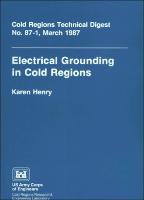Please use this identifier to cite or link to this item:
https://hdl.handle.net/11681/2691| Title: | Electrical grounding in cold regions |
| Authors: | Henry, Karen S. |
| Keywords: | Electricity Electrical currents Electrical grounding Electrical engineering Cold regions Cold weather conditions Frozen ground Permafrost |
| Publisher: | Cold Regions Research and Engineering Laboratory (U.S.) Engineer Research and Development Center (U.S.) |
| Series/Report no.: | Cold regions technical digest ; 87-1. |
| Description: | Cold Regions Technical Digest Introduction: Electrical grounding for temporary and permanent installations in cold regions is complicated by the existence of frozen soil. This is because • The electrical resistivity of frozen soil can be several orders of magnitude higher than unfrozen soil. • The contact resistance between the grounding electrodes and the soil, which is usually negligible under unfrozen conditions, can become significant if a veneer of ice forms on the electrode. • It is difficult to drive grounding rods into frozen soil. The purpose of this digest is to describe the factors to consider when planning a grounding system for permanent and temporary installations in regions of seasonal frost and permafrost. |
| Rights: | Approved for public release; distribution is unlimited. |
| URI: | http://hdl.handle.net/11681/2691 |
| Appears in Collections: | Technical Digest |
Files in This Item:
| File | Description | Size | Format | |
|---|---|---|---|---|
| CR-TD-87-1.pdf | 903.96 kB | Adobe PDF |  View/Open |